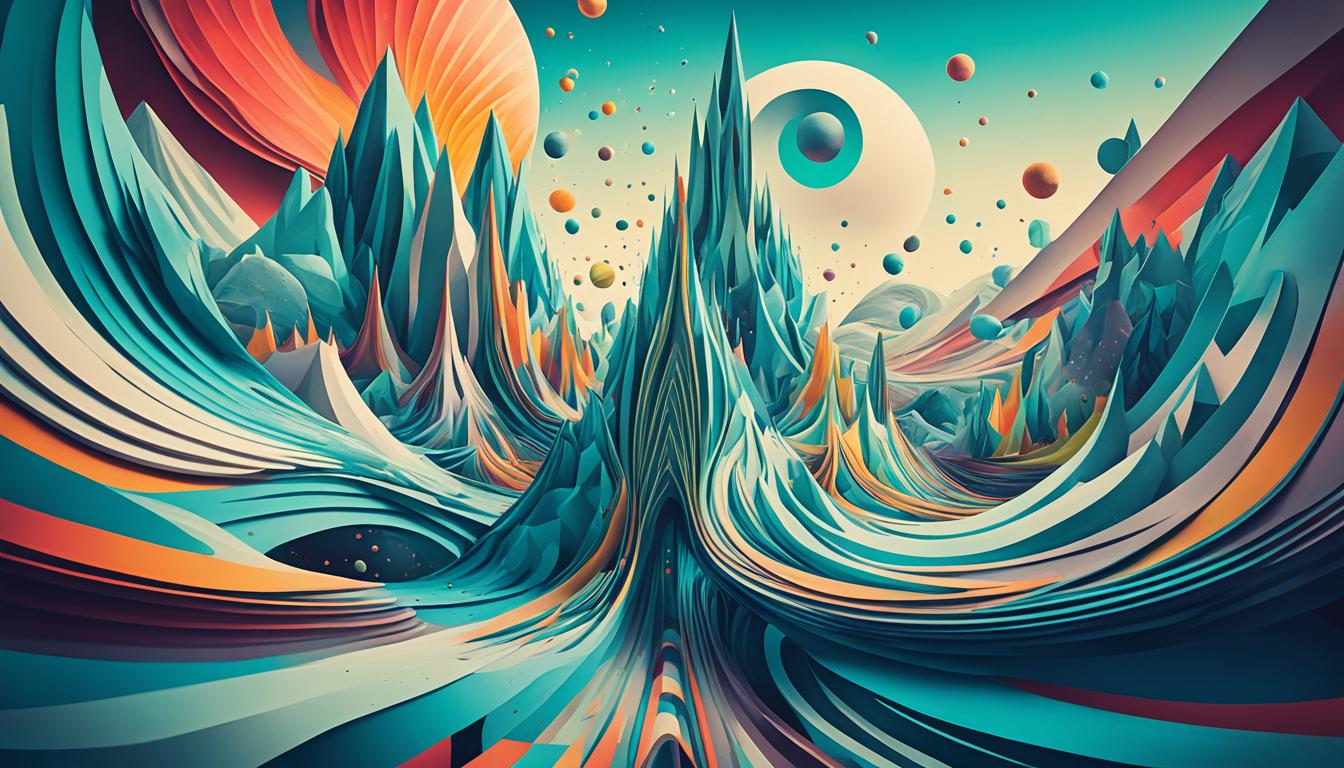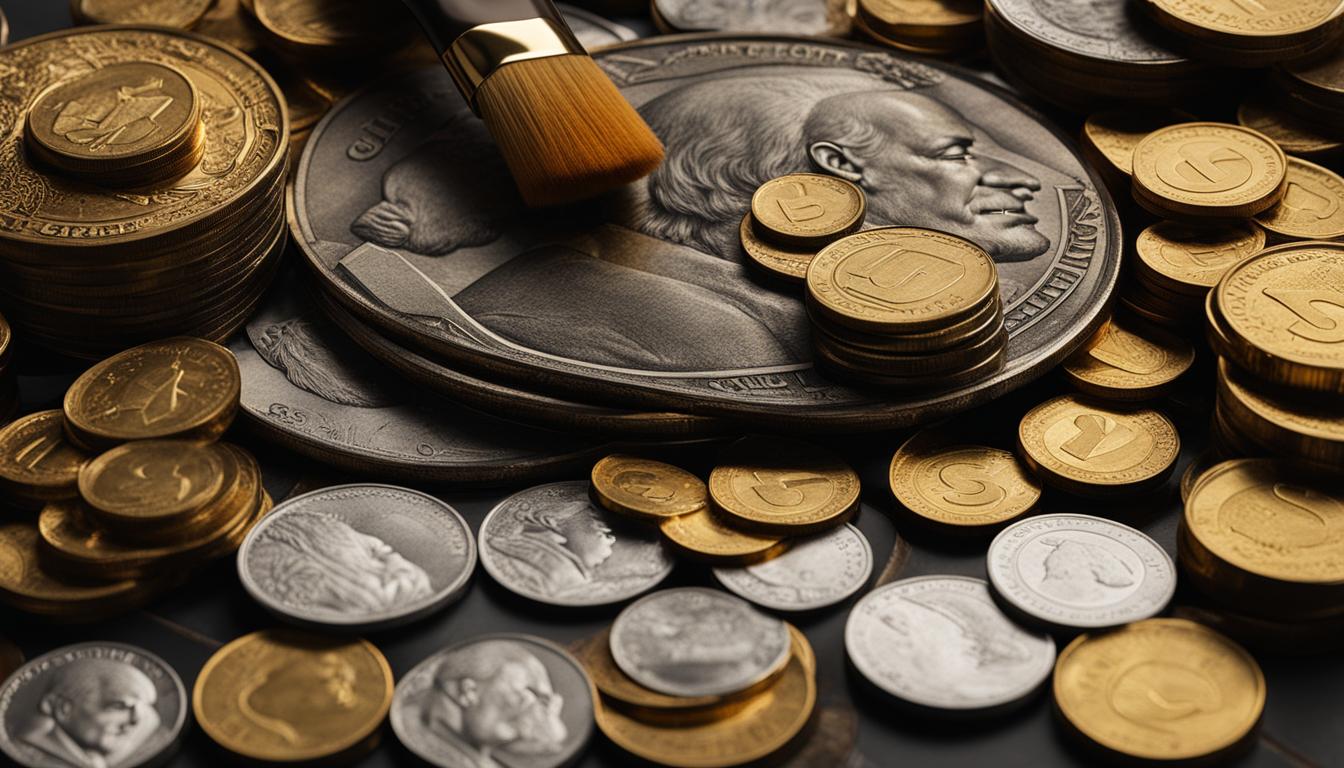When it comes to creating fine art projects, the choice of theme plays a significant role in shaping the narrative and impact of the artwork. At its core, a fine art project should have a powerful underlying message or idea that drives its creation. By exploring various themes and narratives, artists can create profound and meaningful artwork that tells a compelling story.
So, how do you find inspiration for your art project themes? Look no further than nature, literature, personal experiences, cultural traditions, and social issues. These sources can provide a rich and diverse range of themes to explore, enabling you to create artwork that not only resonates personally but also engages and captivates your audience.
Let’s delve deeper into the art of exploring themes and narratives in fine art projects, and discover how you can create impactful artwork that speaks to the heart and mind.
Key Takeaways:
- Choosing a theme that resonates with you is crucial for creating meaningful art projects.
- Inspiration for themes can be found in nature, literature, personal experiences, cultural traditions, and social issues.
- Exploring themes enables artists to create impactful artwork that tells a compelling story.
- Themes help artists connect with their audience on a deeper level and evoke emotions and thoughts.
- Fine art projects allow artists to express their unique voice and perspective through their chosen themes.
Selecting a Theme for Your Art Project
When embarking on an art project, one of the most crucial decisions you’ll make is selecting a theme. The theme sets the foundation for your creative journey, providing inspiration and guidance throughout the artistic process. In this section, we’ll explore the importance of carefully choosing a theme that resonates with you and sparks your creativity.
Art project inspiration can come from various sources, such as personal experiences, cultural influences, and societal observations. By selecting a theme that personally interests you, you’ll be motivated to explore it in depth, resulting in more authentic and meaningful artwork. Consider themes that evoke emotions or provoke thought, as these can create a strong connection between your artwork and the viewer.
Thematic exploration in art allows you to delve into a particular subject or concept from different perspectives. By examining a theme from various angles, you can bring nuance and depth to your artwork. This adds layers of complexity and intrigue, captivating the viewer and inviting them to interpret your work in their unique way.
When choosing a theme, it can be helpful to consider topics that have significant narrative interpretation in fine art. For example, themes like identity, nature, social issues, and historical events offer endless possibilities for exploration. These themes provide rich contexts and offer a platform for you to convey your artistic vision effectively.
Let your personal experiences and emotions guide your narrative interpretation in fine art. Infuse your artwork with your unique perspective and use the visual language of art to convey the depth of your chosen theme. Experiment with different techniques, such as symbolism, composition, and color, to translate your ideas onto the canvas.
“Choosing a theme is like choosing a compass for your artistic journey. It gives you a sense of direction and purpose, guiding your creative decisions and shaping the narrative of your artwork.”
As you embark on your art project, keep in mind that the theme sets the stage for your creative exploration. It fuels your inspiration, guides your thematic exploration, and enhances the narrative interpretation in your artwork. Choose a theme that ignites your passion, stimulates your creativity, and allows you to express your unique voice through your art.
| Benefits of Selecting a Theme for Your Art Project |
|---|
| Provides direction and focus for your creative process |
| Ignites your passion and keeps you motivated |
| Allows for deeper exploration and thematic richness in your artwork |
| Elevates the narrative interpretation of your artwork |
| Creates a strong connection between your artwork and the viewer |
The Power of Visual Storytelling in Art
Visual storytelling in art is a powerful tool that allows artists to convey emotions, messages, and narratives. Through the skillful use of visual elements such as composition, color, texture, and symbolism, artists can create complex stories and ideas that resonate with the audience.
By carefully crafting these visual elements in their artwork, artists can guide the viewer’s interpretation and evoke specific emotions. Whether using realistic representations or abstract imagery, visual storytelling in art has the ability to create a deep and lasting impact on the audience.
Every brushstroke, every line, and every color choice contributes to the overall narrative of the artwork. The composition of the piece influences how the story unfolds, leading the viewer’s eye and enhancing the message being conveyed.
Through visual storytelling in art, artists can transport viewers to different worlds, evoke memories and emotions, and challenge societal norms. It allows us to delve deeper into the artist’s perspective and experience their unique creative vision.
Artistic narrative analysis plays a crucial role in understanding and appreciating visual storytelling in art. By analyzing the choices made by the artist – the use of colors, the arrangement of elements, the symbolism employed – we can gain a deeper understanding of the narrative and the intended message.
The power of visual storytelling in art lies in its ability to transcend language and cultural barriers. It connects with us on a primal level, evoking emotions and sparking our imagination.
The Elements of Visual Storytelling in Art
To further understand the power of visual storytelling, let’s explore some of the key elements that artists use to create a compelling narrative:
- Composition: The arrangement of visual elements within the artwork, such as the placement of objects, figures, and lines, guides the viewer’s eye and influences the flow of the narrative. It can create a sense of harmony or tension, depending on the artist’s intention.
- Color: The choice of colors can evoke different emotions and convey symbolic meanings. Bright and warm colors may represent joy and vitality, while dark and cool colors may evoke a sense of melancholy or mystery.
- Texture: Texture adds depth and tactile qualities to the artwork, enhancing the viewer’s sensory experience. It can evoke feelings of roughness, smoothness, or a sense of touch.
- Symbolism: Symbols are visual representations that carry deeper meanings. Artists use symbols to convey ideas, concepts, or messages that may not be easily expressed through literal representation. These symbols can be culturally specific or universally recognizable.
By skillfully incorporating these elements into their artwork, artists can create visual narratives that captivate and engage the viewer.
| Element | Description |
|---|---|
| Composition | The arrangement of visual elements within the artwork to guide the viewer’s eye and influence the narrative flow. |
| Color | The choice and use of colors to evoke emotions and convey symbolic meanings. |
| Texture | The tactile qualities added to the artwork that enhance the viewer’s sensory experience. |
| Symbolism | The use of visual representations to convey deeper ideas, concepts, or messages. |
Visual storytelling in art allows artists to go beyond words and speak directly to our emotions and imagination. It transcends barriers and offers a universal language that connects us all. Through artistic narrative analysis, we can delve deeper into the layers of meaning and appreciate the rich storytelling traditions that unfold before our eyes.
Exploring Narrative Techniques in Fine Art Projects
In fine art projects, narratives can be explored and interpreted in various ways. Artists have the freedom to use different techniques to convey their narrative and engage the audience. Through the use of sequential art, symbolism, allegory, and metaphor, artists can tell stories and explore themes in a visually compelling manner.
Sequential art, also known as narrative art, involves the arrangement of images in a specific order to create a story. This technique is commonly used in comic books, graphic novels, and storyboarding. By strategically arranging the images, artists guide the viewer through the narrative, creating a sense of progression and immersion.
Symbolism is another powerful technique used in fine art to convey meaning and emotion. Artists use symbols to represent abstract concepts or ideas. These symbols can range from objects and colors to gestures and motifs. By employing symbols, artists can add depth and layers of interpretation to their artwork, inviting the viewer to engage in a deeper exploration of the narrative.
“The use of allegory allows artists to tell stories with hidden meanings and moral messages. Allegorical artworks often contain symbolic representations of abstract ideas, allowing the viewer to interpret the narrative on multiple levels.” – Artist’s Name
Metaphor is a technique that allows artists to express complex ideas and emotions through visual representations. By using one concept or object to represent another, artists create a metaphorical connection that encourages the viewer to reflect and interpret the narrative in a personal and meaningful way.
Whether through a series of artworks or a single piece, narrative exploration in art enables artists to create a connection between the artwork and the viewer. By using these narrative techniques, artists bring their stories to life, fostering a deeper understanding and appreciation for the themes they explore.

| Technique | Description |
|---|---|
| Sequential Art | The arrangement of images in a specific order to create a story, commonly used in comic books, graphic novels, and storyboarding. |
| Symbolism | The use of symbols to represent abstract concepts or ideas, adding depth and layers of interpretation to the artwork. |
| Allegory | The use of symbolic representations of abstract ideas to tell stories with hidden meanings and moral messages. |
| Metaphor | The use of one concept or object to represent another, creating a metaphorical connection that invites personal interpretation. |
The Importance of Theme Analysis in Fine Art
Theme analysis is a critical component of fine art projects, as it allows artists to delve deeper into the underlying ideas and concepts of their work. By analyzing themes, artists can gain a better understanding of the messages they want to convey and how to effectively communicate them through their artwork. This process of thematic exploration in art enables artists to explore different perspectives, challenge societal norms, and engage in meaningful conversations through their art.
When embarking on a fine art project, it is essential to choose a theme that resonates with you and reflects the ideas or concepts you wish to explore. By analyzing the chosen theme, artists can uncover its depth and potential for artistic expression. This artistic narrative analysis enables artists to dig deeper into the theme’s nuances, symbolism, and underlying meanings, allowing them to create more impactful and thought-provoking artwork.
Thematic exploration in art also provides artists with an opportunity to challenge established norms and conventions. By exploring different perspectives and pushing the boundaries of traditional artistic narratives, artists can bring new ideas and interpretations to the forefront. This exploration can spark conversations, provoke emotions, and inspire viewers to see the world from a fresh and unique perspective.
Benefits of Theme Analysis in Fine Art:
- Enhances the depth and meaning of artwork
- Guides artistic decision-making and creative choices
- Encourages exploration of different perspectives and interpretations
- Facilitates conversations about societal issues and cultural concepts
- Creates engaging and thought-provoking artwork
Artists who invest time and effort in theme analysis are better equipped to create artwork that resonates with viewers. By understanding the themes they explore, artists can effectively communicate their ideas, emotions, and beliefs through their art. Through thematic exploration, artists can create a narrative that speaks to a broader audience and initiates a meaningful engagement with their work.
Theme analysis is an integral part of the artistic process, enabling artists to dive deeper into their work, challenge conventions, and create impactful narratives. By exploring themes, artists can open up doors to new perspectives, start important conversations, and make a lasting impact through their art.
| Benefits of Theme Analysis in Fine Art |
|---|
| Enhances the depth and meaning of artwork |
| Guides artistic decision-making and creative choices |
| Encourages exploration of different perspectives and interpretations |
| Facilitates conversations about societal issues and cultural concepts |
| Creates engaging and thought-provoking artwork |
Expressing Emotions and Beliefs through Fine Art Projects
Fine art projects provide artists with a powerful avenue to express their emotions and beliefs. Through their artwork, artists can delve into personal experiences, cultural traditions, and social concerns, communicating their perspectives and inviting viewers to engage with their message on a deeper level.
The use of color, composition, and texture in fine art projects enables artists to evoke specific emotions in their audience. Each brushstroke, each carefully chosen element contributes to the overall impact of the artwork, making it a captivating exploration of the artist’s innermost thoughts and feelings.
Artists have the freedom to create artwork that serves as a reflection of their beliefs and values. Whether it is a painting, sculpture, or mixed media piece, their artistic expression serves as a powerful commentary on the world around us and the experiences that shape us.
Conveying Personal Experiences and Cultural Traditions
Artists often draw inspiration from their own personal experiences when creating their artwork. They use their art as a means to reflect upon and process their emotions, experiences, and memories.
For example, Frida Kahlo, a prominent Mexican artist, infused her artwork with her personal struggles, physical pain, and identity as a Mexican woman. Her self-portraits and symbolic imagery illustrated the complexity of her experiences, inviting viewers into her world.
Additionally, artists may explore and celebrate their cultural heritage through their artwork. They draw inspiration from cultural traditions, customs, and symbols, using art as a vehicle to preserve and transmit cultural identity.
“Art is the lie that enables us to realize the truth.” – Pablo Picasso
Addressing Social Concerns and Provoking Thought
Art has long been used as a platform for addressing social concerns and advocating for change. Artists can use their art to shed light on issues such as inequality, discrimination, environmental destruction, and political unrest, encouraging viewers to reflect on and question the world we live in.
One such example is the work of Ai Weiwei, a Chinese contemporary artist and activist. Through his installations and conceptual art, he has brought attention to human rights issues and the power dynamics between individuals and the state.

Art as a Catalyst for Dialogue and Reflection
Fine art projects provide a space for dialogue and reflection, allowing viewers to engage with the artist’s emotions and beliefs, as well as their own. Art can inspire conversations, challenge preconceived notions, and offer new perspectives.
By exploring themes and expressing their beliefs through their artwork, artists invite viewers to contemplate their own values, identities, and the broader human experience. Art has the power to transcend language barriers and foster connections, uniting individuals through shared emotions and ideas.
Through their fine art projects, artists bring their emotions and beliefs to life, sparking conversations, and leaving a lasting impact on those who engage with their work. It is through this expression in art that we can not only gain a deeper understanding of the artist’s inner world but also explore our own emotions, beliefs, and the world we inhabit together.
Exploring the Possibilities of Fine Art Themes
When it comes to art project themes, the possibilities are truly limitless. As artists, we have the freedom to delve into a wide range of subjects and explore them in unique and creative ways. Whether you’re drawn to the beauty of nature, the complexities of identity, the urgency of social issues, the depth of historical events, or the depths of personal experiences, there is a theme that awaits your artistic interpretation.
By engaging in thematic exploration in art, we can challenge ourselves to look beyond the surface and dive deep into the narratives that inspire us. This exploration allows us to develop our artistic skills, broaden our perspectives, and ultimately create compelling and thought-provoking artwork.
Artists can approach these themes from different angles, using various artistic techniques and mediums to bring their ideas to life. Some may choose to focus on realism, capturing the minute details of their subjects, while others may opt for abstraction, allowing for a more interpretive and symbolic representation. The possibilities are as diverse as the artists themselves.
Let’s take a moment to explore some popular art project themes:
- Nature: The awe-inspiring beauty of the natural world has long served as a muse for artists. From landscapes to wildlife, the wonders of nature offer endless possibilities for creative expression.
- Identity: The exploration of identity, be it personal, cultural, or societal, is a theme that resonates with many artists. Through their artwork, they can delve into questions of selfhood, belonging, and representation.
- Social Issues: Art has the power to shed light on important social issues and inspire change. Artists often tackle topics such as inequality, injustice, and climate change, using their platforms to raise awareness and promote dialogue.
- Historical Events: History provides a wealth of stories and narratives that can be explored through art. Artists can delve into significant events, moments, and figures, shedding new light on the past and its relevance to the present.
- Personal Experiences: Artists often find inspiration in their own lives, using their artwork as a means of self-expression and catharsis. By delving into personal experiences, they can create deeply intimate and meaningful pieces.
Here is a visually engaging table that summarizes these popular art project themes:
| Theme | Description |
|---|---|
| Nature | Explore the beauty and wonders of the natural world. |
| Identity | Delve into questions of personal, cultural, and societal identity. |
| Social Issues | Raise awareness and inspire change through art. |
| Historical Events | Uncover and reinterpret significant moments in history. |
| Personal Experiences | Express and reflect on personal stories and emotions. |
As you can see, each theme offers its own unique opportunities for exploration and narrative interpretation in fine art. Whether you’re captivated by the beauty of nature, intrigued by the complexities of identity, passionate about social change, fascinated by history, or moved by personal experiences, there is a theme waiting for you to bring it to life through your artwork.
So, let your imagination take flight and embark on a journey of thematic exploration in art. Discover the themes that resonate with you and create art that not only speaks to your audience but also reflects the depth of your artistic vision.
Conclusion
Exploring themes and narratives in fine art projects is a creative and fulfilling process. It allows us to delve into the depths of our artistic expression, creating meaningful and impactful pieces that resonate with both ourselves and our audience. By selecting a theme that truly speaks to us, we lay the foundation for a powerful artistic journey.
Analyzing the narrative potential of our chosen theme is essential to creating a compelling artwork. We must dive deep into its layers, unraveling the story that lies within. By understanding the narrative elements of our theme, we can effectively communicate our message and evoke emotions in the viewer through visual storytelling.
Through our artwork, we have the power to express our unique emotions and beliefs. We can share our personal experiences, shed light on social issues, and challenge the status quo. By harnessing the visual elements of art – color, composition, and texture – we create a direct line of communication with our audience, inviting them to connect with our work on a deeper level.
As we embark on our art projects, let us courageously explore themes that inspire and resonate with us. Let us push the boundaries of our creativity, challenge our artistic skills, and create artwork that leaves a lasting impression. Through exploring themes and narratives in our fine art projects, we can truly share our voice and perspective with the world.
FAQ
How do I choose a theme for my art project?
When selecting a theme for your art project, it is important to choose something that personally interests you and sparks your creativity. Look for themes that have depth and can be explored from different perspectives. Consider themes that are thought-provoking, controversial, or emotionally charged.
How can visual storytelling enhance my artwork?
Visual storytelling in art is a powerful tool for conveying emotions, messages, and narratives. Through the use of visual elements such as composition, color, texture, and symbolism, artists can communicate complex stories and ideas. By carefully crafting the visual elements in your artwork, you can guide the viewer’s interpretation and evoke specific emotions.
What techniques can I use to explore narratives in my art project?
In fine art projects, narratives can be explored and interpreted in various ways. Artists can use techniques such as sequential art, symbolism, allegory, and metaphor to convey their narrative. These techniques allow artists to tell stories and explore themes through visual means.
Why is theme analysis important in fine art projects?
Theme analysis plays a crucial role in fine art projects as it helps artists delve deeper into the underlying ideas and concepts of their work. By analyzing themes, artists can better understand the messages they want to convey and how to effectively communicate them through their artwork. Thematic exploration in art allows artists to explore different perspectives, challenge societal norms, and engage in meaningful conversations through their art.
How can I express my emotions and beliefs through fine art projects?
Fine art projects provide artists with a platform to express their emotions and beliefs. Through their artwork, artists can convey personal experiences, cultural traditions, and social concerns. The use of color, composition, and texture can evoke specific emotions in the viewer, allowing them to connect with the artist’s message on a deeper level. Fine art projects give artists the freedom to explore and communicate their innermost thoughts, making their artwork a reflection of their beliefs and values.
What are some possibilities for art project themes?
The possibilities for art project themes are endless. Artists can explore themes such as nature, identity, social issues, historical events, and personal experiences. They can approach these themes from different angles, using various artistic techniques and mediums. By exploring different themes, artists can continuously challenge themselves, develop their artistic skills, and create unique and engaging artwork.
How Can Underwater Photography be Incorporated into Fine Art Projects & Stories?
Underwater photography equipment basics are essential for artists looking to incorporate the beauty of the ocean into their fine art projects and stories. Understanding the proper gear and techniques can help capture stunning images and convey powerful narratives that resonate with audiences.




